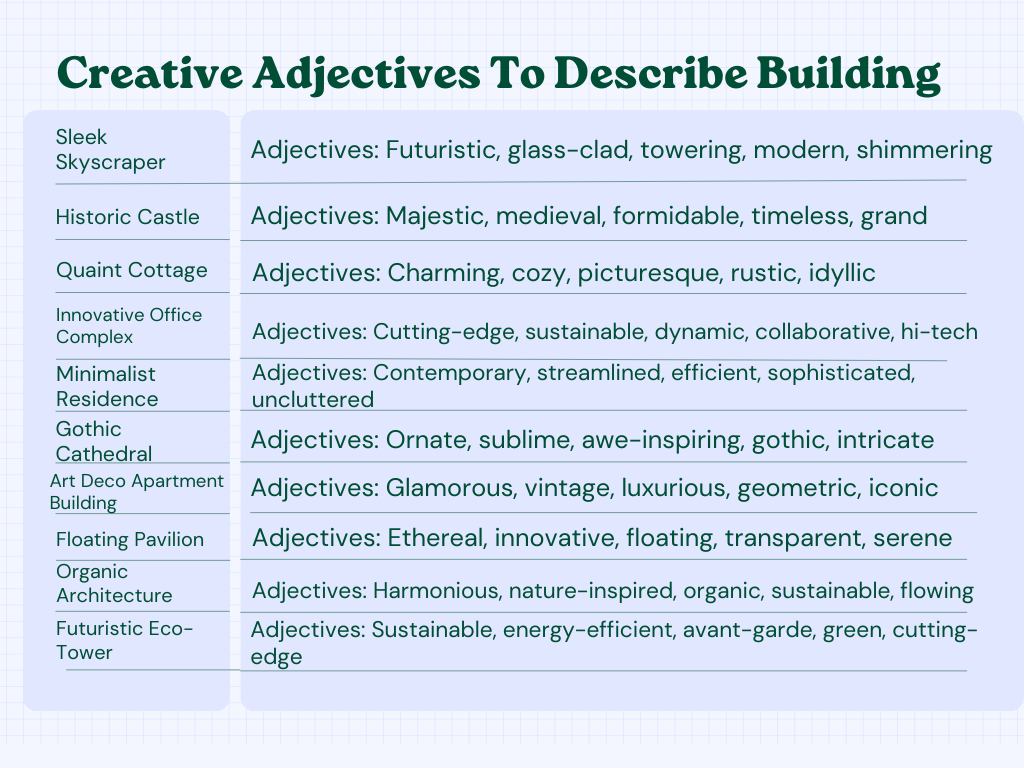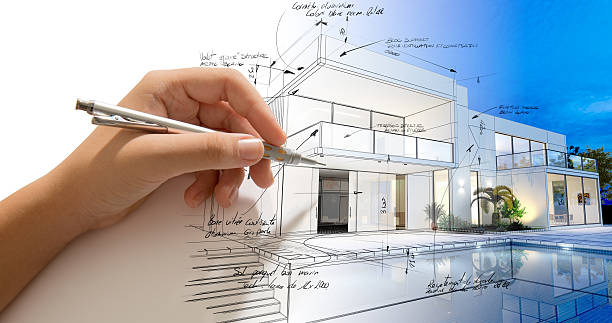How To Describe Buildings In Writing (20 Best Tips & Adjectives)
How To Describe Buildings In Writing
How To Describe Buildings In Writing: In the world of literature, where every word is a brushstroke on the canvas of imagination, the art of describing buildings is a skill that can transform the mundane into the extraordinary.
Buildings, whether they rise defiantly into the sky or nestle quietly in the embrace of a rural landscape, hold the power to become not just settings but integral characters in the stories we tell.
Their architectural features, history, and the emotions they evoke can shape the mood, tone, and atmosphere of our narratives.
In this exploration, we embark on a journey to unravel the secrets of descriptive writing, discovering the nuances of observation, the magic of detail, and the alchemy of words that can bring buildings to life on the page.
So, let us delve into the art of describing buildings in writing, learning how to wield language as a tool to craft vivid, evocative, and unforgettable architectural portraits.
How To Describe Buildings In Writing
Describing buildings in writing can be a detailed and creative process. Here’s a step-by-step guide on How To Describe Buildings In Writing:
Observe Closely
Begin by closely observing the building you want to describe. Take note of its architectural style, materials, colors, and any unique features that stand out.
Gather Information
Research the building’s history, purpose, and any interesting anecdotes or facts about it. This will help you add depth to your description.
Start with an Introduction
Begin your description with a captivating introductory sentence or paragraph that sets the tone and establishes the building’s significance.
Focus on Exterior
Describe the building’s exterior in detail. Mention its size, shape, and overall design. Discuss the architectural elements such as columns, windows, doors, and any decorative elements.
Detail Materials
Note the materials used in construction, whether it’s brick, stone, glass, or something else. Describe the texture and color of these materials.
Discuss Surroundings
Mention the building’s surroundings, including its location in the city or landscape. Describe how it fits into its environment.
Emphasize Unique Features
Highlight any unique or distinctive features that make the building special. These could include ornate carvings, a modern facade, or historical significance.
Interior Description
If applicable and possible, describe the interior of the building. Discuss the layout, decor, and any remarkable details like chandeliers, artwork, or furniture.
Capture Atmosphere
Try to capture the atmosphere or mood the building conveys. Is it imposing, welcoming, historic, or futuristic?
Use Sensory Language
Engage the reader’s senses by using descriptive language that appeals to sight, sound, touch, smell, and even taste if relevant. For example, describe the sound of footsteps echoing in a grand marble foyer.
Tell a Story
Weave a narrative into your description. Share stories or anecdotes related to the building, its construction, or its historical significance.
Create a Vivid Picture
Use vivid and imaginative language to help the reader visualize the building. Paint a picture with your words.
Maintain a Clear Structure
Organize your description logically, perhaps by starting from the exterior and moving to the interior, or by arranging details from top to bottom or front to back.
Revise and Edit
After writing your description, revise and edit it for clarity, conciseness, and coherence. Remove any unnecessary details and refine your language.
Read Aloud
Read your description aloud to ensure it flows well and sounds appealing.
Seek Feedback
If possible, have someone else read your description and provide feedback. They may offer valuable insights or catch errors you missed.
Polish and Finalize
Make any final revisions based on feedback and your own assessments. Ensure that your description is engaging and free from errors.
Include a Conclusion
Wrap up your description with a concluding paragraph that summarizes the building’s significance or impact.
Cite Sources
If you used any sources for information or historical context, make sure to properly cite them.
Proofread
Before publishing or sharing your description, carefully proofread it one last time to catch any remaining errors.
Remember that effective building descriptions not only convey physical details but also evoke emotions and convey a sense of the building’s place in history and culture.

Creative Adjectives To Describe Building
Sleek Skyscraper
Adjectives: Futuristic, glass-clad, towering, modern, shimmering
Historic Castle
Adjectives: Majestic, medieval, formidable, timeless, grand
Quaint Cottage
Adjectives: Charming, cozy, picturesque, rustic, idyllic
Innovative Office Complex
Adjectives: Cutting-edge, sustainable, dynamic, collaborative, hi-tech
Minimalist Residence
Adjectives: Contemporary, streamlined, efficient, sophisticated, uncluttered
Gothic Cathedral
Adjectives: Ornate, sublime, awe-inspiring, gothic, intricate
Art Deco Apartment Building
Adjectives: Glamorous, vintage, luxurious, geometric, iconic
Floating Pavilion
Adjectives: Ethereal, innovative, floating, transparent, serene
Organic Architecture
Adjectives: Harmonious, nature-inspired, organic, sustainable, flowing
Futuristic Eco-Tower
Adjectives: Sustainable, energy-efficient, avant-garde, green, cutting-edge

The Basics of Describing Buildings
Describing buildings is more than just painting a picture with words; it’s an art of unveiling the hidden stories etched into bricks and mortar. It’s about summoning the essence of a structure, conjuring whispers of its past and the promises of its future.
The basics of this craft involve peeling back the layers of stone, concrete, or wood to reveal the soul of a building. It’s not merely about what meets the eye but how it meets the soul.
The play of light on arches, the whispered secrets of creaking floorboards, and the silent history echoing from faded facades—all these facets weave together to create a symphony of words that immerses readers in the very heart of the architectural wonder you wish to describe.
So, grab your literary chisel and let’s embark on an expedition through the maze of bricks and beams, unearthing the beauty and intrigue that lie within.
Building a Descriptive Vocabulary
Building a descriptive vocabulary is like collecting a treasure trove of words, each one a shimmering gem waiting to adorn your writing.
It’s the art of transforming ordinary adjectives into enchanting emblems, adverbs into magic wands, and metaphors into bridges between the known and the unknown.
As a writer, your palette is language, and with each word you add, your literary canvas becomes more vibrant and alive. These words are your architectural tools, allowing you to construct worlds within worlds, crafting prose that lingers in the minds of your readers like an unforgettable melody.
So, embark on this lexical adventure, for in the realm of descriptive vocabulary, you are the alchemist, turning words into pure literary gold.
The art of showing, not telling
The art of showing, not telling, in writing is akin to inviting the reader to be an active participant in the story. Instead of simply spoon-feeding information, it’s about creating a rich tapestry of details, actions, and emotions that allow readers to draw their own conclusions and immerse themselves deeply in the narrative.
It’s the difference between saying, “She was nervous,” and vividly depicting her tapping foot, trembling hands, and the stammer in her voice as she tried to explain herself.
When writers master this technique, they open a door to a more engaging and evocative storytelling experience, where readers can feel, see, and hear the story as if they were right there, peering into the characters’ souls.
In essence, it’s the magic of letting the reader discover the story, one carefully woven thread at a time.
Techniques for Describing Different Types of Buildings
Unlocking the techniques for describing different types of buildings is akin to wielding a set of keys to a captivating world of architectural diversity.
Each building, whether it’s a humble cottage or a towering skyscraper, has its own unique personality waiting to be unveiled through your words.
It’s about the careful selection of your descriptive tools, crafting descriptions that transform simple bricks and mortar into living, breathing characters within your narrative.
Just as you would use a different brushstroke for a tranquil rural landscape compared to a vibrant urban scene, your words must adapt to the architecture at hand.
From the quaint charm of residential structures to the imposing grandeur of historic landmarks, these techniques empower you to capture the essence of buildings, turning them into protagonists in their own right, ready to leave a lasting impression on your readers’ minds.
So, embark on this architectural adventure and let your words become the architectural blueprints of your storytelling dreams.

Residential structures
Residential structures are the silent witnesses to the intimate stories of our lives. Each one has its own character and charm, whether it’s the cozy embrace of a cottage nestled among ancient trees, the modern elegance of a city apartment with a skyline view, or the timeless charm of a suburban home with a white picket fence.
Describing residential structures allows writers to capture the heart of daily life, where the walls hold the echoes of laughter, tears, and countless memories.
From the warm glow of a hearth in a rustic cabin to the sleek lines of a contemporary penthouse, residential buildings offer a canvas upon which authors can paint the dreams and aspirations of their characters, making them feel like homes to both the reader and the inhabitants within the pages of a story.
Commercial and industrial buildings
Commercial and industrial buildings stand as the beating heart of bustling economies and innovation hubs. These architectural giants are not just structures; they are the pulse of productivity and commerce.
From the towering skyscrapers that house corporate empires to the sprawling warehouses that harbor the engines of industry, they symbolize the relentless march of progress.
Describing commercial and industrial buildings grants writers the opportunity to evoke the dynamic energy of the business world, where glass and steel frames house the dreams and endeavors of countless individuals.
It’s in these structures that the spirit of ambition, innovation, and hard work is encapsulated, where the hum of activity reverberates through the walls and the promise of success lingers in the air.
Whether in the gleaming storefronts of high-end boutiques or the labyrinthine depths of manufacturing plants, these buildings become canvases on which writers can paint the intricate tapestry of modern life, where commerce and creativity intersect.
Historic or landmark buildings
Historic and landmark buildings are the time capsules of our shared human history, standing proudly as enduring testaments to the past.
These architectural marvels are like guardians of memory, their weathered facades whispering tales of bygone eras. Whether it’s a medieval castle with its imposing battlements or an ornate cathedral with its soaring spires, each of these structures carries within it a unique narrative of culture, heritage, and evolution.
Describing historic and landmark buildings is akin to unlocking the doors of time, allowing writers to transport readers to different epochs, where the echoes of history resonate through the stones and arches.
The intricate carvings, stained glass windows, and intricate masonry work become not just decorative details but windows into the souls of generations past, reminding us of the enduring power of human craftsmanship and imagination.
Describing Buildings in Different Settings
Describing buildings in different settings is like navigating a vast and ever-changing landscape of architectural dreams. It’s an art of adaptation, where the buildings become chameleons, seamlessly blending into their surroundings and reflecting the essence of the environment they inhabit.
Whether it’s the steel and glass monoliths that rise from the concrete canyons of urban jungles, the rustic cottages nestled in the tranquil embrace of countryside meadows, or the fantastical spires that punctuate the skyline of otherworldly realms, each setting demands a unique lexicon of words and emotions to convey its character.
As a writer, you become an architect of words, crafting descriptions that breathe life into structures, making them not just a part of the backdrop, but integral players in the grand symphony of your storytelling.
It’s a journey that leads you through a myriad of landscapes, from the familiar to the fantastical, and in each one, the buildings become not just structures but portals into the very soul of the setting itself.

Painting a picture of idyllic countryside scenes
Painting a picture of idyllic countryside scenes is like dipping one’s brush into the palette of tranquility and serenity.
It’s the art of summoning the essence of pastoral beauty, where rolling hills meet endless horizons, and quaint cottages nestle amidst fields of wildflowers.
Describing the countryside is an invitation to embrace the symphony of nature’s colors and sounds, from the golden hues of sun-kissed wheat fields to the gentle murmur of babbling brooks.
The landscape comes alive with the vibrant characters of grazing cattle, fluttering butterflies, and the whispered secrets of ancient oaks. Each stroke of description is a stroke of connection to a simpler, more harmonious existence, where the rhythms of life are dictated by the rising sun and the setting moon.
In these scenes, writers have the power to transport readers to a realm where time slows, and the heart finds solace in the tranquil embrace of nature’s perfection.
Enhancing world-building in speculative fiction
Enhancing world-building in speculative fiction is akin to wielding a literary wand, conjuring realms that exist beyond the boundaries of the ordinary.
It’s the craft of architecting entire universes from the foundations of imagination, layering intricate details upon the blank canvas of the mind.
In these fantastical worlds, the buildings are not mere structures but living organisms, reflecting the very essence of the setting.
Whether it’s floating cities among the clouds, ancient temples infused with magic, or futuristic metropolises teeming with advanced technology, each architectural element becomes a brushstroke on the canvas of the reader’s mind.
As writers, we have the privilege of sculpting landscapes that defy reality, offering readers the opportunity to explore the infinite possibilities of the human imagination.
In this realm, buildings are not just bricks and mortar; they are keystones to unlocking the secrets of the fantastical realms we create, enriching our stories with depth and wonder.
Incorporating Building Descriptions into Your Writing
Incorporating building descriptions into your writing is akin to weaving an intricate tapestry of time, place, and emotion. It’s the art of making architecture a character in your narrative, breathing life into bricks and mortar.
These descriptions are not mere backdrops; they are the stage upon which your story unfolds. Like a skilled director, you choose the lighting, the angles, and the props to evoke the desired emotions and reactions from your readers.
Whether it’s the haunting elegance of a decrepit mansion, the gleaming promise of a futuristic cityscape, or the rustic charm of a countryside cottage, each building holds the potential to engage your readers on a visceral level.
It’s in these meticulously crafted descriptions that your story’s setting becomes a character in its own right, shaping the plot, influencing the mood, and leaving an indelible imprint on the reader’s imagination.
So, as a writer, remember that in the world you create, buildings are not just structures; they are the silent narrators of your tale, and through your words, they whisper secrets and dreams that captivate your audience.
Case Studies and Examples
Case studies and examples are the breadcrumbs on the path to mastery, the flashlight in the dark cave of understanding.
They’re the vivid stories that breathe life into theory, turning abstract concepts into tangible realities. Like windows into different worlds, they invite us to peer through the glass and see how ideas take shape in the messy, unpredictable terrain of real life.
They’re not just data points or anecdotes; they’re the sparks of insight that ignite our curiosity and illuminate the path forward.
Whether it’s exploring the triumphs and tribulations of historical figures, dissecting the strategies of successful businesses, or delving into the intricate dance of cause and effect in science, case studies and examples are the narrative threads that weave the fabric of knowledge.
So, let them be your compass, your inspiration, and your guide as you embark on your journey of discovery and enlightenment.
Frequently Asked Questions (FAQ) about How To Describe Buildings In Writing
What is the importance of describing buildings in writing?
Describing buildings in writing can provide readers with a vivid sense of place, history, and atmosphere. It enhances storytelling, creates visual imagery, and sets the scene in various forms of literature and communication.
Can you describe a building’s interior as effectively as its exterior?
Yes, describing a building’s interior can be just as effective. You can discuss its layout, decor, furnishings, and ambiance to create a more immersive and comprehensive description.
Should I focus on historical or architectural details when describing a building?
The choice depends on your purpose. If you want to emphasize the building’s historical significance, focus on its backstory. For architectural appreciation, delve into its design, materials, and unique features.
How do I make my building description more engaging to readers?
Engage readers by using sensory language, evoking emotions, and telling stories related to the building. Engaging descriptions appeal to sight, sound, touch, smell, and even taste.
What’s the best way to organize a building description?
Organize your description logically, often starting with the exterior and moving to the interior. Alternatively, you can structure it by detailing elements from top to bottom, front to back, or in a sequence that makes sense for your narrative.
Can I use metaphors and similes to describe buildings?
Yes, metaphors and similes can be powerful tools to make your descriptions more vivid. For example, you can compare a modern skyscraper to a towering glass monolith.
How do I balance detail with conciseness in building descriptions?
Balance is key. Include enough detail to paint a picture, but avoid overwhelming the reader with excessive information. Focus on the most significant and impactful elements.
Should I include historical anecdotes when describing a building?
Including historical anecdotes can add depth and interest to your description. They can highlight the building’s place in history and make it more engaging for readers.
Can I use a building’s description as a setting in my fiction writing?
Absolutely! Building descriptions can serve as essential settings in fiction, enhancing the story’s atmosphere and providing a backdrop for events and character interactions.
Are there any common mistakes to avoid when describing buildings in writing?
Avoid using overly technical jargon that might confuse readers. Also, be cautious of being too repetitive or providing too much information. Strive for clarity and balance in your descriptions.
Can I describe fictional or imaginary buildings using the same principles?
Yes, you can apply the same principles to describe fictional or imaginary buildings. The key is to create a detailed and immersive description that helps readers visualize and connect with your imaginary world.
How do I ensure my building description stands out and is unique?
To make your description unique, focus on the building’s distinctive features, its emotional impact, and the stories it tells. Avoid clichés and strive for originality in your language and perspective.
What’s the role of research in building description?
Research can provide historical context, interesting facts, and architectural details that can enrich your description. It adds authenticity and depth to your writing.
Can I use building descriptions in non-fiction, such as travel writing or journalism?
Yes, building descriptions are valuable in various forms of non-fiction writing, especially travel articles, architectural reviews, and historical pieces. They help readers connect with the subject matter and provide valuable information.
Remember that effective building descriptions should not just inform but also engage and inspire readers, allowing them to form a deeper connection with the subject.
Conclusion
In the conclusion of How To Describe Buildings In Writing, where words are our palette and imagination knows no bounds, the art of describing buildings in writing stands as a testament to the richness of human expression.
Through this journey, we have explored the power of keen observation, the intricacies of detail, and the magic of language in bringing buildings to life within our narratives.
As writers, we now possess the tools to craft architectural masterpieces with words, forging connections between readers and the settings we create.
Whether we evoke the hustle and bustle of urban landscapes, the tranquility of pastoral scenes, or the grandeur of historic landmarks, our descriptions have the potential to captivate, resonate, and transport.
So, let us continue to embrace this craft, painting with our literary brushes, weaving buildings into the very fabric of our stories, and leaving indelible imprints of the worlds we create in the hearts and minds of our readers.






